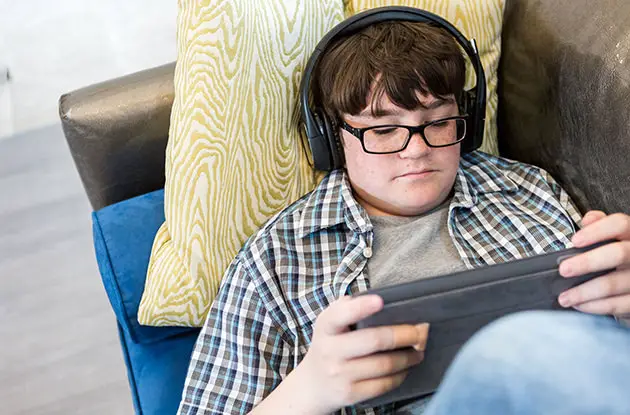Every day after school Peter comes home, drops his backpack and heads to his room to grab his laptop. Before he even gets a snack, he’s logged on and surfing between YouTube and his favorite video games. Unless an adult intervenes, he’ll spend the rest of his afternoon locked in an online trance.
Peter is not unlike most 13-year-old boys in this country. Instead of heading to the ball field after school, or hanging out with friends, Peter spends his afternoons online. If he has homework he does exactly what’s required, never more. He gets A’s and B’s but has been conditioned to believe that learning is a means to an end (doing well on tests) and not a means in itself. He’s rare in that he enjoys reading for fun, but views reading as an activity to pursue when he’s not able to get online, not as a pleasurable way to spend his leisure time.
In many ways Peter is the quintessential modern boy, and that’s the problem, according to Leonard Sax, M.D., Ph.D., a primary care physician in Maryland, and the author of four books, including Boys Adrift: The Five Factors Driving the Growing Epidemic of Unmotivated Boys and Underachieving Young Men. The 2009 book was updated and re-released this year, and examines why boys are less ambitious and less resilient than they were 20 years ago.
Dr. Sax argues that a combination of social, cultural, and biological factors has created a toxic environment that leaves boys disengaged from school, less likely to go to college (and of those who do, less likely to earn a degree), and more apt to live with their parents as adults. Currently, one-third of men ages 22-34 are still living at home, which is a nearly 100-percent increase in the past 20 years. Meanwhile, the proportion of girls who are anxious and depressed has at least quadrupled; it’s risen at a much higher rate than the rate for boys.
“I need to stress that girls are not the winners here,” Dr. Sax says.
Between the book’s initial release and the revision this year, the problem has only got worse, according to Dr. Sax.
“We now have a great deal more research showing the growing gender gap in academic achievement—with boys falling further and further behind—not because girls are doing better, but because boys are doing worse,” Dr. Sax says. “If the gender gap was growing because girls were doing better, that wouldn’t be a problem. That would be cause for celebration.”
Dr. Sax says the gap is evident in many parameters, both formal and informal. For instance, girls are less likely to read for fun in their spare time than they were 30 years ago. But American boys have practically stopped reading for fun.
“The gender gap widened not because girls are reading more but because boys stopped reading,” Dr. Sax says.
RELATED: Find Educational Resources Near You
Contributions to the Decline
A number of factors have contributed to the situation, including a cultural shift in which political sensibilities have infiltrated the household, leaving Americans uncomfortable with the notion of authority, the decline of masculine role models, the need to make schools more boy-friendly, misguided parenting, and an over-reliance on pharmaceuticals to control children, according to Dr. Sax.
“American parents are now parenting their kids badly, compared to other countries. An American kid is now fourteen times more likely to be on medication for ADD compared to a kid in the U.K. An American kid is forty times more likely to be on medication for bipolar disorder than a kid in Germany. In this country we use schizophrenia medications to keep kids from having temper tantrums. There’s been a collapse of parenting in the United States,” Dr. Sax says.
Parents are grappling with challenges not faced by their parents, particularly the proliferation of screens and social media. We learn to parent from our own parents, and if we can’t draw on experience, we look to our peers for guidance. The problem with this approach, according to Dr. Sax, is many parents don’t have a clue what they’re doing.
“I encourage parents to turn off the screens,” Dr. Sax says. “We have a great deal of research showing the more time kids spend in front of a screen, the less engaged they are in the real world. We have very substantial evidence that finds that screens actively undermine kids’ ability to concentrate and focus.”
The American Academy of Pediatrics recently came out with new guidelines, recommending no more than 40 minutes of screen-time a night during the week and 1 hour on weekends. Even if parents turn off the screens at home, however, a growing number of students are looking at screens in school.
“I think a big piece of it is too much technology in their daily lives, there’s such a rush to get the technology into the classrooms,” says Greg Stott, an eighth-grade science teacher at the Francis C. Richmond School in Hanover, NH, where students have individual iPads. “The students look to that for stimulation, and when that’s not provided, they don’t know what to do.”
“I’m not a fan of the iPad program. Parents can limit screen time at home, but we’re not thinking that maybe we should limit screen time here at school,” Stott says.
He added that students are less willing to solve problems, and that boys in particular either don’t know how to begin or simply give up. Girls tend to be more meticulous, more patient; girls typically do better overall because they do better work. Boys tend to be more impulsive, get it done quickly, and don’t go back and check their work.
“This generation of young adults seems to be expecting stuff and when it doesn’t come through, they’re at a loss of what to do, and maybe that’s why a lot of them move back home and don’t have the motivation to get out,” Stott says.
Peter Gray, Ph.D., research professor in the department of psychology at Boston College, has seen a profound lack of resilience among college students, which he attributes to the change in parenting and education methods over the past 50 years. Part of the problem, he says, is children are not left to their own devices to play outside, to push their own limits, and to get into situations or conflicts with other children that they must solve.
Get the Best Family Activities
Sent to You Weekly!
“Children are almost always in the presence of adults. They’re not getting into trouble and out of trouble, and negotiating with their playmates. We’re depriving children of free play, and we’re seeing the consequence of that in college students,” says Dr. Gray, author of Free to Learn: Why Unleashing the Instinct to Play Will Make Our Children Happier, More Self-Reliant, and Better Students for Life.
Paradoxically, though “helicopter parenting” has turned out kids who are unable to cope with the slightest set back at college (a fight with a roommate or a bad grade, for instance). Parents have ceded their power to their kids because of their own discomfort with authority. Too many parents today are asking their children what they want—from meals to vacations—rather than setting the rules.
RELATED: The Mentor Effect
A Lack of Role Models in Pop Culture
Another major cultural shift Dr. Sax cites among the causes of failing boys is the decline of masculinity. He argues that any woman can teach any boy math, language arts, science, and social studies, but what it means to be a man has to be taught by a community of men.
“We used to have such a community, and we used to teach this,” Dr. Sax says. “Fifty years ago there were many institutional and informal associations that brought men and boys together. Those bonds have been broken among English speakers in the United States.”
He added that even if a father never spoke to his son about what it means to be a man, 50 years ago the boy would be watching shows such as Father Knows Best, My Three Sons, or the Andy Griffith Show, or going to the movies and seeing men such as Sidney Poitier, Paul Newman, or Gary Cooper.
“Those movies and shows taught boys that being a man means being courteous, being competent, being knowledgeable, being productive, and being caring. Even if the father was not a good role model, the culture was teaching the boy, this is what we expect of a man,” Dr. Sax says.
He was quick to point out that he’s not suggesting the 1960s were the good old days, saying every era has its challenges. Though Andy Griffith is a great role model for boys, the show itself depicts a racist and misogynistic era. Dr. Sax advises parents to watch the show with their boys, to explain the inequities.
Today, we have The Simpsons, in which Homer is a lazy bum who thinks about food and beer all day, and Bart is an idiot. Dr. Sax says he has a great deal of respect for the show and its understanding of cultural shifts in America, but that it is hardly Father Knows Best.
But The Simpsons is not an outlier. In his research, Dr. Sax went through 150 of the most popular television shows of 2015, and could not find one that portrayed the father as consistently competent. He specifically mentioned Disney shows, in which parents are clueless and the butt of jokes.
“That’s a really profound change in American culture,” Dr. Sax says.
Stott also noted the influence of television on boys, particularly the show Family Guy.
“All the boys love that show. It’s so shallow, and he’s a poor role model. I can see that playing into it,” Stott says.
RELATED: How Can I, as a Father, Be a Good Role Model?
Closing the Gap
Television shows from the 1950s and ’60s depict another important difference from modern life: Children are free to play on their own (both in and out of school) and often get into sticky situations. Indeed, many plots turn on the child doing something reckless and learning a valuable lesson as a result.
In today’s hyper-vigilant world, children have fewer and fewer opportunities to challenge themselves through play. No where is this more evident than at school, where the fear of litigation has turned playgrounds into outdoor gym classes, where adults closely supervise play, and many kids stand idly looking at their phones.
“Over the last forty years education changed in multiple ways, and schools became less friendly to boys,” Dr. Sax says. “Are kids allowed to throw snow balls on school grounds during school hours? No. We used to throw snowballs and the teachers would come out and join us. Today if a kid starts throwing snowballs a teacher comes running out to stop him.”
Dr. Sax says there is a better way that costs nothing. He suggests making the football field the designated snowball throwing zone, where both boys and girls can choose to participate, or holding a tournament with teachers setting up targets and letting the kids compete.
He added that boys’ behavior must be channeled and it extends to the classroom. For instance, he says many boys like to write violent stories. An acceptable story might be a generic depiction of violence that suits the period being written about (Roman gladiators, for example). Writing a story depicting personal or threatening violence is out of bounds.
“Boys understand in bounds versus out of bounds very well,” Dr. Sax says.
There’s been so much concern about gender parity in schools that we’ve thrown the baby out with the bathwater. Dr. Sax says gender is complicated but it doesn’t mean gender doesn’t matter.
“What boys need to get excited about school is different from what girls need, and if you don’t understand that, you end up with what we have, which is a lot of boys who think school is just for girls,” Dr. Sax says. “If we don’t turn the tide we’ll have boys who are less likely to be engaged in the real world and more likely to be looking at their screens, and less likely to fulfill their potential.”
RELATED: Get Family Activities Sent to You










